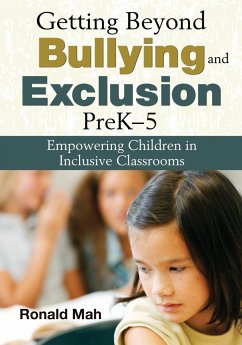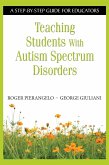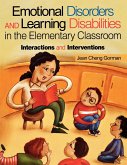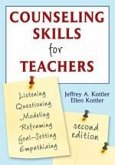- Broschiertes Buch
- Merkliste
- Auf die Merkliste
- Bewerten Bewerten
- Teilen
- Produkt teilen
- Produkterinnerung
- Produkterinnerung
Examines why children with special needs are bullied, how teachers can prevent bullying, ways to work with overprotective parents, and how a self-esteem prescription plan can help.
Andere Kunden interessierten sich auch für
![Improving Schools Through Community Engagement Improving Schools Through Community Engagement]() Kathy Gardner ChadwickImproving Schools Through Community Engagement68,99 €
Kathy Gardner ChadwickImproving Schools Through Community Engagement68,99 €![Teaching Students with Autism Spectrum Disorders Teaching Students with Autism Spectrum Disorders]() Roger PierangeloTeaching Students with Autism Spectrum Disorders90,99 €
Roger PierangeloTeaching Students with Autism Spectrum Disorders90,99 €![Emotional Disorders and Learning Disabilities in the Elementary Classroom Emotional Disorders and Learning Disabilities in the Elementary Classroom]() Jean Cheng GormanEmotional Disorders and Learning Disabilities in the Elementary Classroom40,99 €
Jean Cheng GormanEmotional Disorders and Learning Disabilities in the Elementary Classroom40,99 €![Your Special Education Rights Your Special Education Rights]() Jennifer LavianoYour Special Education Rights23,99 €
Jennifer LavianoYour Special Education Rights23,99 €![The Big Book of Special Education Resources The Big Book of Special Education Resources]() George GiulianiThe Big Book of Special Education Resources38,99 €
George GiulianiThe Big Book of Special Education Resources38,99 €![Counseling Skills for Teachers Counseling Skills for Teachers]() Jeffrey A KottlerCounseling Skills for Teachers86,99 €
Jeffrey A KottlerCounseling Skills for Teachers86,99 €
Examines why children with special needs are bullied, how teachers can prevent bullying, ways to work with overprotective parents, and how a self-esteem prescription plan can help.
Hinweis: Dieser Artikel kann nur an eine deutsche Lieferadresse ausgeliefert werden.
Hinweis: Dieser Artikel kann nur an eine deutsche Lieferadresse ausgeliefert werden.
Produktdetails
- Produktdetails
- Verlag: Corwin
- Seitenzahl: 154
- Erscheinungstermin: 1. Oktober 2009
- Englisch
- Abmessung: 254mm x 178mm x 9mm
- Gewicht: 304g
- ISBN-13: 9781412957236
- ISBN-10: 1412957230
- Artikelnr.: 26251871
- Herstellerkennzeichnung
- Libri GmbH
- Europaallee 1
- 36244 Bad Hersfeld
- gpsr@libri.de
- Verlag: Corwin
- Seitenzahl: 154
- Erscheinungstermin: 1. Oktober 2009
- Englisch
- Abmessung: 254mm x 178mm x 9mm
- Gewicht: 304g
- ISBN-13: 9781412957236
- ISBN-10: 1412957230
- Artikelnr.: 26251871
- Herstellerkennzeichnung
- Libri GmbH
- Europaallee 1
- 36244 Bad Hersfeld
- gpsr@libri.de
Ronald Mah, an educator and licensed marriage and family therapist, has worked in early childhood education for 16 years. A credentialed elementary and secondary teacher, he is the author of Difficult Behavior in Early Childhood and The One-Minute Temper Tantrum Solution (2006 and 2008, Corwin Press). He wrote the Asian Pacific Islander Parent Education Support curriculum (DHS-San Francisco, 1996). Mah has DVDs on child development and behavior (Fixed Earth Films), and has been involved in community and high school mental health clinics, severe emotional disturbance, at-risk youth, welfare-to-work, and Head Start programs. A graduate college instructor and Board of Directors member of the California Association of Marriage and Family Therapists and of the California Kindergarten Association, Mah combines concepts, principles, and philosophy with practical techniques and guidelines for effective and productive results. Mah has a psychotherapy practice in San Leandro, California where he works with children, teens, adults, couples, and families.
Acknowledgments About the Author Introduction Inclusion Means... Inclusion Means More Inclusion Means Less Educational Challenge Exclusion...and Bullying Compromising the Intent of Inclusion Continuums or Labels Three Perspectives 1. Inclusion, Exclusion, and Bullying The Chicken Spends Its Whole Life... The Hawk Spends Its Whole Life... Anxious Vulnerability Please Please Please... The Loud Aggressive "Victim" Becomes a Bully Victim Entitlement to Bully and Intellectual Bullying Classification Creates Targets for Exclusion 2. The Stress, Frustrate, Fail, Suffer Method and Emotional Intelligence The Real World The First S Is for Stress--Stress
Em! The First F Is for Frustration--Frustrate
Em! F Is for Failure--Let
Em Fail! (Make Sure They Fail!) The Second S Is for Suffer--Let
Em Suffer Emotional Intelligence 3. Create Powerful and Successful Children Win So He Would Throw a Tantrum The Next SS Is for Sensitivity and Support The Next SS Is for Skills and Strength SF Is for Survive and Flourish 4. Social Cues Who Is This Kid? Reasons Individuals Don
t Get it! 5. Reasons for Missing Social Cues Physical Disability--Compensation (No.2 of 11): "What? Huh?" Cross-Culture Issues--Cross-Culture Education (No. 3 of 11): "So that
s what you mean!" Overstimulation--De-Stress (No. 4 of 11): "I
m tired. I don
wanna have fun!" Denial--Alleviate Fear (no. 5 of 11): "Nah, nah, nah!" Anxiety--Stabilize and Secure (No. 6 of 11): "What? Where? Watch out? Where? Now? Oh no!" Neurosis--Reality Filter or Check (No. 7 of 11): "That was then, and this is then." Dissassociation--Trauma Work (No. 8 of 11): "Click...This station is no longer broadcasting...or receiving." Learning Dissabilities--Compensation (No. 9 of 11): "Trying hard, harder, and harder..." Attention Deficit Hyperactivity Disorder (and Attention Deficit Disorder)--Focus (No. 10 of 11): "Attention wanders..." Intoxication and Substance Abuse--Sobriety (No. 11 of 11): "Common adverse effects..." 6. The Victim Dynamic Why Do You Pick Up Crying Babies? Victimized by Victims Reversing the Dual Theory of Frailty How Victims Are Created 7. Creating Bullies A Blustering, Browbeating Person Bullies, Aggression, and the Search for Self-Esteem "Who Are you Looking At!?" "Huh? What?" 8. Relational Aggression "You Can
t Come to My Birthday Party" What Do You Mean..."We?" 9. Frustration to Resentment to Aggresstion Lost Self-Esteem Bullies With Learning Disabilities Bullies With ADHD 10. Arrogance and Entitlement Bullies With Asperger Syndrome Bullies With Gifted Abilities 11. Motivation and Survival Adult Stress, Frustration, Failure (and Suffering) "Or Else What?" Internalized Motivation Cultural Characteristics of Children With Challenges Conclusion The Ninety-Second-a-Day Self-Esteem Prescription Plan A Last Thought References Index
Em! The First F Is for Frustration--Frustrate
Em! F Is for Failure--Let
Em Fail! (Make Sure They Fail!) The Second S Is for Suffer--Let
Em Suffer Emotional Intelligence 3. Create Powerful and Successful Children Win So He Would Throw a Tantrum The Next SS Is for Sensitivity and Support The Next SS Is for Skills and Strength SF Is for Survive and Flourish 4. Social Cues Who Is This Kid? Reasons Individuals Don
t Get it! 5. Reasons for Missing Social Cues Physical Disability--Compensation (No.2 of 11): "What? Huh?" Cross-Culture Issues--Cross-Culture Education (No. 3 of 11): "So that
s what you mean!" Overstimulation--De-Stress (No. 4 of 11): "I
m tired. I don
wanna have fun!" Denial--Alleviate Fear (no. 5 of 11): "Nah, nah, nah!" Anxiety--Stabilize and Secure (No. 6 of 11): "What? Where? Watch out? Where? Now? Oh no!" Neurosis--Reality Filter or Check (No. 7 of 11): "That was then, and this is then." Dissassociation--Trauma Work (No. 8 of 11): "Click...This station is no longer broadcasting...or receiving." Learning Dissabilities--Compensation (No. 9 of 11): "Trying hard, harder, and harder..." Attention Deficit Hyperactivity Disorder (and Attention Deficit Disorder)--Focus (No. 10 of 11): "Attention wanders..." Intoxication and Substance Abuse--Sobriety (No. 11 of 11): "Common adverse effects..." 6. The Victim Dynamic Why Do You Pick Up Crying Babies? Victimized by Victims Reversing the Dual Theory of Frailty How Victims Are Created 7. Creating Bullies A Blustering, Browbeating Person Bullies, Aggression, and the Search for Self-Esteem "Who Are you Looking At!?" "Huh? What?" 8. Relational Aggression "You Can
t Come to My Birthday Party" What Do You Mean..."We?" 9. Frustration to Resentment to Aggresstion Lost Self-Esteem Bullies With Learning Disabilities Bullies With ADHD 10. Arrogance and Entitlement Bullies With Asperger Syndrome Bullies With Gifted Abilities 11. Motivation and Survival Adult Stress, Frustration, Failure (and Suffering) "Or Else What?" Internalized Motivation Cultural Characteristics of Children With Challenges Conclusion The Ninety-Second-a-Day Self-Esteem Prescription Plan A Last Thought References Index
Acknowledgments About the Author Introduction Inclusion Means... Inclusion Means More Inclusion Means Less Educational Challenge Exclusion...and Bullying Compromising the Intent of Inclusion Continuums or Labels Three Perspectives 1. Inclusion, Exclusion, and Bullying The Chicken Spends Its Whole Life... The Hawk Spends Its Whole Life... Anxious Vulnerability Please Please Please... The Loud Aggressive "Victim" Becomes a Bully Victim Entitlement to Bully and Intellectual Bullying Classification Creates Targets for Exclusion 2. The Stress, Frustrate, Fail, Suffer Method and Emotional Intelligence The Real World The First S Is for Stress--Stress
Em! The First F Is for Frustration--Frustrate
Em! F Is for Failure--Let
Em Fail! (Make Sure They Fail!) The Second S Is for Suffer--Let
Em Suffer Emotional Intelligence 3. Create Powerful and Successful Children Win So He Would Throw a Tantrum The Next SS Is for Sensitivity and Support The Next SS Is for Skills and Strength SF Is for Survive and Flourish 4. Social Cues Who Is This Kid? Reasons Individuals Don
t Get it! 5. Reasons for Missing Social Cues Physical Disability--Compensation (No.2 of 11): "What? Huh?" Cross-Culture Issues--Cross-Culture Education (No. 3 of 11): "So that
s what you mean!" Overstimulation--De-Stress (No. 4 of 11): "I
m tired. I don
wanna have fun!" Denial--Alleviate Fear (no. 5 of 11): "Nah, nah, nah!" Anxiety--Stabilize and Secure (No. 6 of 11): "What? Where? Watch out? Where? Now? Oh no!" Neurosis--Reality Filter or Check (No. 7 of 11): "That was then, and this is then." Dissassociation--Trauma Work (No. 8 of 11): "Click...This station is no longer broadcasting...or receiving." Learning Dissabilities--Compensation (No. 9 of 11): "Trying hard, harder, and harder..." Attention Deficit Hyperactivity Disorder (and Attention Deficit Disorder)--Focus (No. 10 of 11): "Attention wanders..." Intoxication and Substance Abuse--Sobriety (No. 11 of 11): "Common adverse effects..." 6. The Victim Dynamic Why Do You Pick Up Crying Babies? Victimized by Victims Reversing the Dual Theory of Frailty How Victims Are Created 7. Creating Bullies A Blustering, Browbeating Person Bullies, Aggression, and the Search for Self-Esteem "Who Are you Looking At!?" "Huh? What?" 8. Relational Aggression "You Can
t Come to My Birthday Party" What Do You Mean..."We?" 9. Frustration to Resentment to Aggresstion Lost Self-Esteem Bullies With Learning Disabilities Bullies With ADHD 10. Arrogance and Entitlement Bullies With Asperger Syndrome Bullies With Gifted Abilities 11. Motivation and Survival Adult Stress, Frustration, Failure (and Suffering) "Or Else What?" Internalized Motivation Cultural Characteristics of Children With Challenges Conclusion The Ninety-Second-a-Day Self-Esteem Prescription Plan A Last Thought References Index
Em! The First F Is for Frustration--Frustrate
Em! F Is for Failure--Let
Em Fail! (Make Sure They Fail!) The Second S Is for Suffer--Let
Em Suffer Emotional Intelligence 3. Create Powerful and Successful Children Win So He Would Throw a Tantrum The Next SS Is for Sensitivity and Support The Next SS Is for Skills and Strength SF Is for Survive and Flourish 4. Social Cues Who Is This Kid? Reasons Individuals Don
t Get it! 5. Reasons for Missing Social Cues Physical Disability--Compensation (No.2 of 11): "What? Huh?" Cross-Culture Issues--Cross-Culture Education (No. 3 of 11): "So that
s what you mean!" Overstimulation--De-Stress (No. 4 of 11): "I
m tired. I don
wanna have fun!" Denial--Alleviate Fear (no. 5 of 11): "Nah, nah, nah!" Anxiety--Stabilize and Secure (No. 6 of 11): "What? Where? Watch out? Where? Now? Oh no!" Neurosis--Reality Filter or Check (No. 7 of 11): "That was then, and this is then." Dissassociation--Trauma Work (No. 8 of 11): "Click...This station is no longer broadcasting...or receiving." Learning Dissabilities--Compensation (No. 9 of 11): "Trying hard, harder, and harder..." Attention Deficit Hyperactivity Disorder (and Attention Deficit Disorder)--Focus (No. 10 of 11): "Attention wanders..." Intoxication and Substance Abuse--Sobriety (No. 11 of 11): "Common adverse effects..." 6. The Victim Dynamic Why Do You Pick Up Crying Babies? Victimized by Victims Reversing the Dual Theory of Frailty How Victims Are Created 7. Creating Bullies A Blustering, Browbeating Person Bullies, Aggression, and the Search for Self-Esteem "Who Are you Looking At!?" "Huh? What?" 8. Relational Aggression "You Can
t Come to My Birthday Party" What Do You Mean..."We?" 9. Frustration to Resentment to Aggresstion Lost Self-Esteem Bullies With Learning Disabilities Bullies With ADHD 10. Arrogance and Entitlement Bullies With Asperger Syndrome Bullies With Gifted Abilities 11. Motivation and Survival Adult Stress, Frustration, Failure (and Suffering) "Or Else What?" Internalized Motivation Cultural Characteristics of Children With Challenges Conclusion The Ninety-Second-a-Day Self-Esteem Prescription Plan A Last Thought References Index







